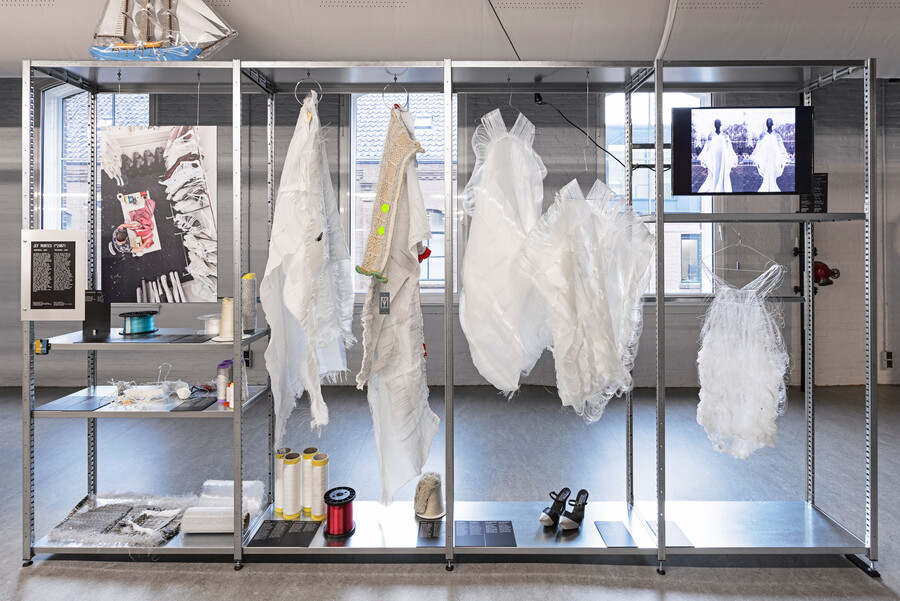After countless experiments with adaptive yarns in the TextielLab, fashion designer Jef Montes developed Adaptive Archi-Filament, a new yarn that changes shape when it comes into contact with water. Together with Judith Peskens, he wove 42 dresses with the yarn. They all started out as squares of material; the rain then tailored each one.
“When dress 33 came off the loom, I was really unhappy. It was so bulky and stiff, made from some 10 kilometres of yarn. It wasn’t at all what I imagined. But after a month on the roof, it turned out to be everything I wanted: suddenly, all the other dresses were eclipsed.” That element of surprise is inherent in Jef Montes’ intensive R&D process in the TextielLab. Over the past year, he has produced 42 dresses with product developer Judith Peskens, each with a different combination of weaves. He describes the co-creation process as a continuous journey of discovery, with each person bringing their own expertise to the table. He likes being surprised by how others interpret his vision. This vision focuses on how textiles can change shape with little interference from the designer, such as creating a 3D garment from a flat fabric without cutting it, and therefore avoiding waste. “As a designer who’s recently graduated, you have ideas about sustainability – fashion can no longer just be about trends and aesthetics – but you actually know very little about the raw materials you work with. I was really curious about that.”
Architectonic
Over time, these raw materials – yarns – have taken on an increasingly important role in Montes’ design process. A few years after graduating, he contacted the TextielLab, “I wanted to investigate how the use of adaptive yarns could lead to a new form of tailoring.” He initially experimented on a loom with a white cotton warp and water-soluble weft. In a subsequent phase, he changed the warp from white to black, and later replaced the cotton with monofilament, which, in combination with the fragile, soluble yarn, created an architectonic effect. “These tests clarified for me that I wanted to keep looking for something that doesn’t dissolve completely when it comes into contact with water.”
Water-soluble coating
Montes travelled around Europe with the samples he had made in the TextielLab to find investors for a new type of adaptive yarn. “The samples allowed me to show that I wasn’t just daydreaming.” After a successful crowdfunding campaign, he made his international debut in 2017 during Paris Fashion Week with the ‘Tormenta’ collection – a predecessor of ‘Marinero’. A nomination for the Hyères Fashion Award secured his place in the Re-FREAM project, for which he immersed himself in the technical world of yarns at the Spanish textile institute Aitex. With the help of chemists, technicians and product developers, he was able to develop a signature filament: Adaptive Archi-Filament. “It’s an elongated elastic thread made from recycled plastic from the sea, among other things, which is frozen in a water-soluble coating.” He sent 80 kilometres of the yarn to Tilburg, where he and the product developers set to work developing ‘Marinero’, a collection of dresses inspired by life in and with the sea.
On the roof
All 42 dresses were woven as squares, with floats – loose threads – for the head and arms. Water was then needed to tailor each one. The dresses were displayed on mannequins and placed outside on the roof. Over time, the rain moulded the garments to the mannequins’ bodies. These changes can be seen in the videos made for the project. The most dramatic transformation occurred in the first week, but the entire process took about half a year. Three mannequins have also been placed on the TextielMuseum’s roof. These are visible if you look out of the window from the ‘Secrets of Making’ exhibition. The mannequins will soon get new dresses, at which point the natural tailoring process can be followed from day to day.

Jef Montes in the exhibition ‘The Secrets of Making’.
Seaweed
The pieces on display in the exhibition lie somewhere between an art installation and haute couture, but Montes says that he is now ready to create a wearable collection for the middle market. “I can use everything I learned in the lab for the collection.” He openly shares the knowledge he has gained, with the aim of inspiring others. “I also hope that the TextielLab will include my yarn in their yarn collection, so that other designers can work with it.” In the meantime, he is already thinking about the next step, which involves replacing rainwater with seawater and using yarns made from biobased seaweed. Dresses that grow in the sea and provide food for the fish as they are being produced? According to Montes, that’s not a daydream either.